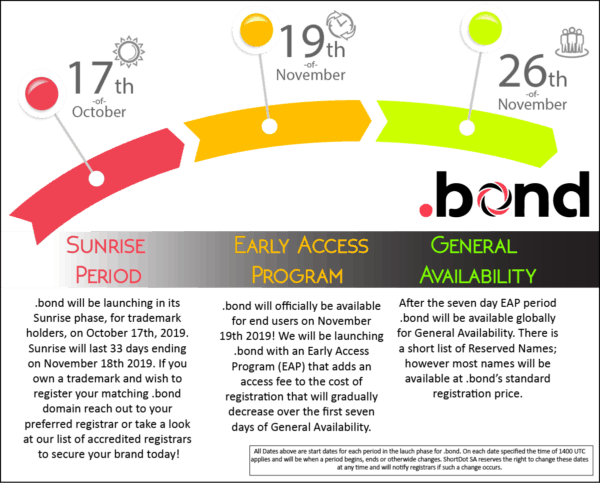In this day and age, you have to be smart with your time.
The Internet Corporation for Assigned Names and Numbers, otherwise known as ICANN, has adopted the New gTLD Program in efforts to allow individuals and companies to strategize when registering their domain names as the technological landscape continues to evolve.
Below you will find the availability phases of a domain launch, aiding you in understanding what goes behind the official launch of a domain name, and what it takes to get the one you want.
What is a New gTLD?
Released by ICANN in January 2014 , they are a large set of new generic top-level domain (gTLD) extensions. If you were wondering, a TLD extension is the part of a domain name following the period (for example, wikipedia.ORG).
These TLDs are different than other gTLDs like .COM, .NET, and .ORG.
ICANN started the New gTLD Program with the idea of greatly expanding the Domain Name System (DNS). Its initiative is “to enhance innovation, competition, and consumer choice” (according to their website). New gTLDs are fresh territory for individuals and businesses wanting to distinguish themselves from the crowd.
The list is continuously growing. That is why it is important to take ahold of a New gTLD while you can. But before a New gTLD officially gets its foot in the door, it must follow a cycle of different launch phases.
One of the New gTLDs recently made available by ICANN is the .BOND domain. If you’ve been keeping up with new developments in the domain name industry, you may be aware that .BOND has had a bit of an unusual lifecycle—first available to Bond University exclusively and almost abandoned from lack of use, it was acquired and revitalized by the registry ShortDot. Luckily, because of the systems that ICANN has in place, all of that turmoil could be excised from the name, and now it is open for general registration just like any other domain name. Below you will find some explanation of the process that new domain names go through before becoming public, and how .BOND managed to recover from near extinction to become one of the newest gTLDs.
Sunrise Period
The Sunrise Period for a new domain name is a period during which the name is made available, but only to certain organizations that hold trademarks. In fact, in order for a company to register the domain during this period, all requests must be processed through the Trademark Clearinghouse (TMCH) that ICANN has created.
This period usually lasts between 30 and 60 days. .BOND’s Sunrise, for instance, began on October 17 of 2019 and lasted for 33 days, ending on November 18, although it was originally planned to Sunrise for 60 days, starting on July 9th. The purpose of the Sunrise Period is to allow companies who already hold trademarks to have access to the domain from the get-go, encouraging both initial adoption and minimizing the risk of legal struggles involving trademark infringements. By ensuring that at least a few powerful organizations can pick up a new domain without the risk of complications, ICANN can get the ball rolling with regards to more widespread adoption.
Ultimately, though, the purpose of .BOND’s Sunrise, at least according to the domain’s owners ShortDot, is to allow companies to “secure their brand.”
And so, the Sunrise Period creates a golden opportunity for trademark owners/copyright holders, bestowing them an all-access period to which they can secure their trademark on the new TLD. It is like standing in line for tickets you badly want—the earlier you get there, the higher the chance you will get what you want.
Landrush or Early Access Period (EAP)
Following the Sunrise Period, the Landrush or Early Access period works a little like the Hunger Games. It is open to everyone, so things can get a little crazy.
The only domains not offered to everyone during this period are Premium Domains, which are domains reserved at higher values so that they must be sold or auctioned off at much higher prices. Premium Domains are priced significantly higher because of what they bring to a website, giving strong branding opportunities.
In the case of .BOND, because it was designed to be a general name with no real user restrictions (as opposed to a domain like .BANK that has a laundry list of prerequisites for registration), the EAP phase was more akin to the General Availability phase, plus a variable fee. While the Landrush for some domains may last around a month before entering General Availability, .BONDs Landrush lasted only 7 days. This phase began on November 19, and during this time, any one, from huge corporations to users like you, were able to register a .BOND domain for its regular retail price, plus a fee. This fee decreased as the 7 days went on.
However, some registrants choose to wait until the General Availability stage before registering in order to get a lower price. However, by doing so, they knowingly take the risk that the name might not be available at that point. When doing this, registrants walk a fine line between spending a ton of money early on to secure their domain or saving money at risk of someone taking their potential domain name (it is important to note if someone orders in an earlier phase, the earlier phase always takes priority).
General Availability Period
The final stage, the General Availability period, follows all Sunrise, Landrush, and EAP periods when they are done and through. This stage means that the new gTLD is now fully released and the new gTLD is open to everyone on a first come, first served basis.
The high prices for earlier access to specific domain names are lowered considerably. Standard retail and wholesale prices are distributed to customers and registrars. And so, when purchasing a domain name during this period, a new gTLD is no different than purchasing a gTLD like .COM or .NET.
.BOND entered its General Availability phase on the 26th of November, after a week long EAP, as promised; however, the domain is still not 100% open to all. There is a small list of what are called Reserved Names, which are names that are blacklisted by the registry and are not available through typical registration. ShortDot has not released a list of these names, nor their reasoning behind reserving them, but that is no cause for alarm. Reserving a small selection of domain names upon unveiling a new gTLD is a common practice, and reasons for doing so can range from “name collisions” to not wanting to release one or two character names to preserving names that the registry thinks might be particularly valuable.
Not all new gTLDs will be priced the same … even within the same company. Yet, it must be said that the lowest prices for new gTLDs will always be available during the General Availability stage.

Patience is not always a virtue…
Now you might be wondering: what happens when companies evaluate the likelihood of obtaining their domain, taking the risk, and waiting until the General Availability period … and then they do not get their domain name? What happens next?
Well, some new gTLDs offer preorders before their launch into the General Availability stage. Preordering gives companies the opportunity to try and register the domain name their heart so desires right when the new gTLD officially launches.
By preordering through a domain registrant, on the General Availability launch date, they will attempt to register the domain name for you, improving your chances of grabbing the domain name you want. However, nothing is guaranteed here either, and it is not always the case that you will be able to register the domain name you ordered.
That being said, there are no shortages of good domain names available right now just waiting to be picked up. If you feel like a .BOND domain might be the right choice for your new financial website, James Bond fan blog, or anything else, you can head over to one of ShortDot’s accredited registrars, such as 101domain, to secure one for yourself.









